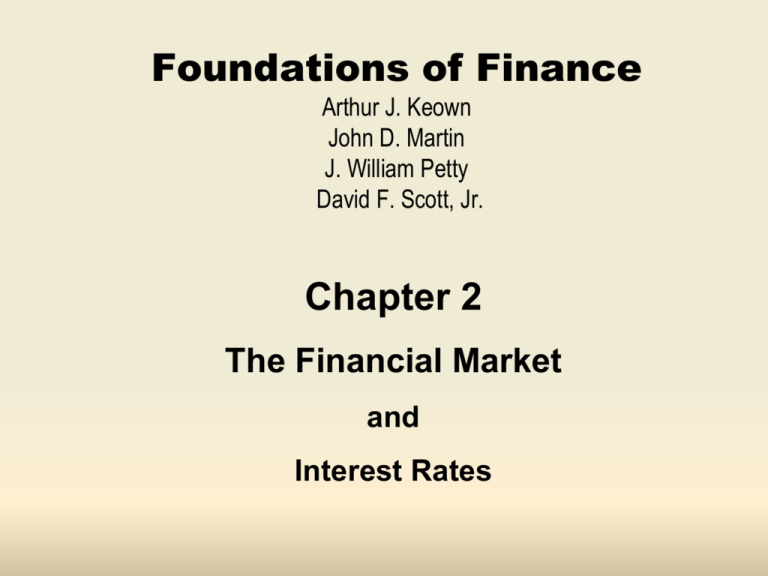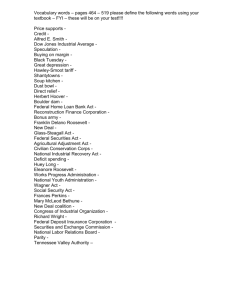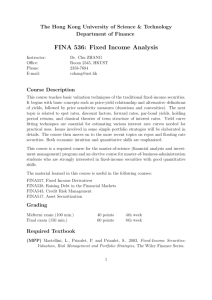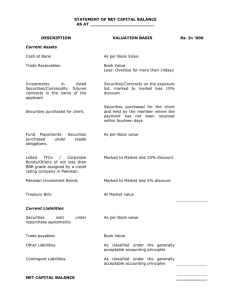
Foundations of Finance
Arthur J. Keown
John D. Martin
J. William Petty
David F. Scott, Jr.
Chapter 2
The Financial Market
and
Interest Rates
Chapter Objectives
• Understanding the historical relationship between
internally generated and externally generated sources of
funds.
• Understand the financing mix that tends to be used by
the firms raising long-term capital.
• Explain why the financial markets exist in a developed
country.
• Explain the financing process by which savings are
supplied and raised by major sectors in the economy.
Chapter Objectives
• Describe key components of the U.S. financial market
system.
• Understand the role of the investment-banking business
in the context of raising corporate capital.
• Distinguish between privately placed securities and
publicly offered securities.
• Be acquainted with securities floatation costs and
securities markets regulations.
Chapter Objectives
• Understand the rate-of-return relationships among
various classes of financing vehicles that persist in the
financial markets.
• Be acquainted with recent interest rate levels and the
fundamentals of interest rate determination.
• Explain the popular theories of the term structure of
interest rates.
• Understand the relationships among the multinational
firm, efficient financial markets, and the inter-country
risk.
Principles Used in this Chapter
Principle 1: The Risk-Return Tradeoff - We Won’t
Take on Additional Risk Unless We Expect to Be
Compensated with Additional Return.
Principle 6: Efficient Capital Markets - The Markets
are Quick and the Prices Are Right.
Principle 10: Ethical Behavior Is Doing the Right
Thing, and Ethical Dilemmas Are Everywhere in
Finance.
Federal Funds Rate
• Short-term market rate of interest
• Serves as a sensitivity indicator of the
direction of future changes in interest rates
Federal Reserve System
• Known as “The Fed”
• Central Bank of the United States
• Responsibilites:
•
•
•
•
Conducting Nation’s Monetary Policy
Supervise and Regulate Banking Institutions
Maintain Stability of Financial Systems
Provide Financial Services
Federal Reserve System
• Independent Entity within the Federal
Government
• Derives Authority from Federal Government
• How they get income
• Accountable to Congress
• Chairman is ______________
Objectives of the Fed
• Maximum sustainable employment
• Price stability
Federal Reserve System
Federal Reserve System
Federal Reserve System
Federal Reserve System
Board of Governors
• Seven members
• Nominated by the President and confirmed by the Senate.
• A full term is fourteen years. One term begins every two years, on
February 1 of even-numbered years.
• A member who serves a full term may not be reappointed but a member
who completes an unexpired portion of a term may be reappointed.
• All terms end on their statutory date regardless of the date on which the
member is sworn into office.
• The Chairman and the Vice Chairman of the Board are named by the
President from among the members and are confirmed by the Senate.
They serve a term of four years. A member's term on the Board is not
affected by his or her status as Chairman or Vice Chairman.
Federal Reserve System
Board of Governors
Commissioner
Ben S. Bernanke, Chairman
Janet L. Yellen, Vice Chair
Entered
Office
Term
Expires
02/01/06
01/31/20
10/04/10
01/31/24
Jerome H. Powell
05/01/12
01/31/14
Elizabeth A. Duke
08/05/08
01/31/12
Daniel K. Tarullo
01/28/09
01/31/22
Sarah Bloom Raskin
10/04/10
01/31/16
Jeremy C. Stein
10/30/12
01/31/18
www.federalreserve.gov
Recent Interest Rate Cycles
Early 1994 & Inflation
1997
Fall 1998
International Pressures
Summer 1999 Tight labor markets, aggregate real growth,
inflation
Early 2001
Contracting manufacturing output, slower
business capital spending, equity market sell-off,
recession
Firming Labor market, stronger retail sales,
improving industrial production, hot housing
Summer 2004 market, increases in energy prices, all suggesting
unacceptable future rates of inflation.
Raise interest
Rates
Lower interest
Rates
Raise interest
Rates
Lower interest
Rates
Raise interest
Rates
Nonfinancial Corporate Business
Sources of Funds, 1981-2000
• Changes in market
conditions influence the
way corporate funds are
raised
• Example: High interest
costs discourage the use
of debt.
External
Funds
27.70%
Internal
Funds
72.30%
Corporate Securities Offered for Cash
• Nonfinancial Corporations3yr. Cash Weighted Average,
2001-2003
Equities
14.30%
• Total Volume($M)
– $1,288,515
Source:Statistical Supplement to the
Federal Reserve Bulletin, Table 1.46,
October 2004, A29.
Bonds
and
Notes
85.70%
Debt/Equity Mix
• U.S. tax system favors debt as means of
raising capital
• Interest expense is deductible
• Dividends paid are not deductible
Financial Markets
• Financial markets are institutions and procedures
that facilitate transactions in all types of financial
claims
• Financial markets exist in order to allocate the
supply of savings in the economy to the demanders
of those savings.
Financial Markets
• Real assets are tangible assets such as
houses, equipment, and inventories.
• Financial assets represent claims for future
payments in other economic units.
Financial Markets
• Underwriting — the purchase of financial claims of
borrowing units and reselling them at a higher price to
other investors.
• Secondary Markets — trading in already existing
financial claims
• Financial Intermediaries — major financial institutions,
i.e. commercial banks, savings and loans, credit unions,
life insurance companies, mutual funds etc.
Financial Markets
• Indirect Securities – financial claims offered by
financial intermediaries to economic units with excess
savings
• Direct Securities – financial claims purchased by
financial intermediaries with proceeds from the sale of
indirect securities
The Financing Process
Sector
Funds
Raised ($)
Funds
Supplied ($)
Net Funds
Supplied ($)
Households
447.4
397.1
(50.3)
Nonfinancial Corporate
Business
447.5
383.8
(63.7)
U.S. Gov’t
73.9
62.9
(11.0)
State and Local Gov’ts
56.4
48.4
( 8.0)
320.2
561.7
241.5
Foreign
Source: Flow of Funds Accounts, First Quarter 2000, Flow if Funds Section, Statistical Release Z.1
(Washington, D.C.; Board of Governors of the Federal Reserve System, June 9,2000).
Movement of Savings
• Direct Transfer of Funds
• Indirect Transfer of Funds Using an
Investment Banker
• Indirect Transfer of Funds Using the
Financial Intermediary
Three Ways to Transfer Financial
Capital in the Economy
Three Ways to Transfer Financial Capital in the Economy
2 - 25
Foundations of Finance
Pearson Prentice Hall
Public Offerings and Private
Placements
• Public Offering – both individuals and institutional
investors have the opportunity to purchase securities
• Private Placement (direct placement) – the securities
are offered and sold to a limited number of investors
Primary and Secondary Markets
Primary Markets – Securities are offered for the first time
to investors – a new issue of stock. Increases the total
stock of financial assets outstanding in the economy.
Secondary Markets – Transactions in currently
outstanding securities. All transactions after the initial
purchase. Sales do not affect the total stock of financial
assets that exist in the economy.
Money Market and Capital Market
Money Market: all institutions and procedures
that provide for transactions in short-term debt
instruments
Capital Market: all institutions and procedures
that provide for transactions in long-term financial
instruments
Organized Security Exchanges and
Over-the-Counter Markets
Organized Security Exchanges — Tangible
entities; physically operate space, where financial
instruments are traded on the premises
• National and regional exchanges
Over-The-Counter Markets — All security markets
except the organized exchanges
• Money Market
Organized Security Exchanges and
Over-the-Counter Markets
• The business of an Exchange, including securities
transactions, is conducted by Members.
• Officer of the firm is designated to be the “Member”
of the Exchange, which then permits the brokerage
house to use the facilities to effect trades.
Stock Exchange Benefits
• Provides a continuous market
• Establishes and publicizes fair security prices
• Helps businesses raise new capital
Listing Requirements
• Listing criteria varies for each exchange.
• General requirements include:
• Profitability
• Market Value
• Public Ownership
New York Stock Exchange (NYSE)
• “The Big Board”
• Origins back to 1792.
• Automated in 1995 using wireless hand held computers (HHC).
• As of Jan. 24, 2007 all stocks can be traded using HHC.
• 1366 seats on the exchange
• In 2005, seat sold for $3.25 million.
• Operated by NYSE Euronext
• Acquired American Stock Exchange (AMEX) in Oct. 1, 2008
Over the Counter Market (OTC)
• For firms who don’t meet listing requirements of major
exchanges.
• Avoids major exchange reporting requirements and fees.
• More stocks and over 90% of corporate bonds traded on the
OTC than on organized exchanges.
• Trading done through brokers and broker - dealers.
• National Association of Security Dealers Automated
Quotation System. (NASDAQ)
• “Screen Based – Floorless Market”
Original Dow Jones Companies
American Cotton Oil Company – now part of Unilever.
American Sugar Company – became Domino Sugar in 1900 - now Domino Foods, Inc.
American Tobacco Company – broken up in a 1911 antitrust action.
Chicago Gas Company – now an operating subsidiary of Integrys Energy Group.
Distilling & Cattle Feeding Company – now Millennium Chemicals which is in Chapter 11 bankruptcy.
General Electric Company – still in operation
Laclede Gas Company – still in operation as the Laclede Group, Inc., removed from the DJIA in 1899.
National Lead Company – now NL Industries, removed from the DJIA in 1916.
North American Company – electric utility holding company broken up by the SEC in 1946.
Tennessee Coal, Iron and Railroad Company – bought by U.S. Steel in 1907.
U.S. Leather Company – dissolved in 1952.
United States Rubber Company – changed its name to Uniroyal in 1961 - bought by Michelin in 1990
Current Dow Jones Companies
Company
3M Co.
Stock Symbol
MMM
Primary Group
Diversified Industrials
Alcoa Inc.
AA
Aluminum
American Express Co.
AXP
Consumer Finance
T
Telecommunications
AT&T
Bank of America
BAC
Banking
Boeing Co.
BA
Aerospace
Caterpillar Inc.
CAT
Commercial Vehicles & Trucks
CVX
Integrated Oil and Gas
Chevron
Cisco Systems
CSCO
Coca-Cola Co.
KO
Soft Drinks
DD
Commodity Chemicals
E.I. DuPont de Nemours
Exxon Mobil Corp.
Banks
XOM
Integrated Oil & Gas
General Electric Co.
GE
Diversified Industrials
Hewlett-Packard Co.
HPQ
Computer Hardware
Home Depot Inc.
HD
Home Improvement Retailers
Honeywell International Inc.
HON
Diversified Industrials
Intel Corp.
INTC
Semiconductors
International Business Machines Corp.
IBM
Computer Services
Johnson & Johnson
JNJ
Pharmaceuticals
JPMorgan Chase & Co.
JPM
Banks
UnitedHealth Group
UNH
Managed Healthcare
McDonald's Corp.
MCD
Restaurants & Bars
Merck & Co. Inc.
MRK
Pharmaceuticals
Microsoft Corp.
MSFT
Software
Pfizer Inc.
PFE
Pharmaceuticals
Procter & Gamble Co.
PG
Nondurable Household Products
Travelers Corp.
TRV
Insurance
United Technologies Corp.
UTX
Aerospace
Verizon Communications Inc.
VZ
Fixed Line Telecommunications
Wal-Mart Stores Inc.
Walt Disney Co.
WMT
DIS
Broadline Retailers
Broadcasting & Entertainment
Investment Banker
• A financial specialist involved as an
intermediary in the merchandising of
securities; facilitates flow of savings from
economic units that want to invest in those
units that want to raise funds.
Functions of an
Investment Banker
• Underwriting
• Distributing
• Advising
Distribution Methods
• Negotiated Purchase
• Competitive Bid Purchase
• Commission or Best Efforts Basis
• Privileged Subscription
• Direct Sales
Private Placements
• Advantages
– Speed
– Reduced Flotation Costs
– Financing Flexibility
• Disadvantages
– Interest Costs
– Restrictive Covenants
– Possible Future SEC Registration
Flotation Costs
• Incurred by the firm raising the capital
• Sensitive to the risk involved with successfully distributing a
security
• Types
– Underwriters Spread
– Issue Costs
•
•
•
•
•
Printing and Engraving
Legal Fees
Accounting Fees
Trustee Fees
Other
Market Regulation
• Securities Act of 1933
• Securities Exchange Act of 1934
• Securities Acts Amendments of 1975
Securities Exchange Act of 1933
• Securities Act of 1933 — Aims to provide potential
investors with accurate, truthful disclosure about the
firm and new securities being offered.
Securities Exchange Act of 1934
• Created SEC to enforce federal securities laws
• Major security exchanges must register with the SEC
–
–
–
–
Insider trading is regulated
Prohibits manipulative trading
SEC control over proxy procedures
Gives Board of Governors of Federal Reserve System
responsibility for setting margin requirements
Securities Acts Amendments
of 1975
• Created a national market system (NMS)
SEC Rule 415 – Shelf Registration
• Shelf Registration or Shelf Offering is a
procedure for issuing new securities where
the firm obtains a master registration
statement approved by the SEC
Sarbanes-Oxley Act of 2002
• In July 2002, Congress passed the Public
Accounting and Reform and Investor Protection Act
• The Act contains 11 titles which tighten significantly
the latitude given corporate advisors who have
access to or influence company decisions.
Sarbanes-Oxley Act of 2002
Key Elements
•
•
•
•
•
•
•
•
•
•
•
Public Company Accounting Oversight Board
Auditor Independence
Corporate Responsibility
Enhanced Financial Decisions
Analysts Conflicts of Interest
Commission Resources and Authority
Studies and Reports
Corporate and Criminal Fraud Accountability
White-Collar Crime Penalty Enhancements
Corporate Tax Returns
Corporate Fraud and Accountability
Rates of Return in Financial Markets
• Opportunity Cost — Rate of return on next best
investment alternative to the investor
• Standard Deviation — Dispersion or variability around the
mean, or average of the rate of return in the financial
markets
• Maturity Premium — Additional return required by
investors in long-term securities to compensate them for
greater risk of price fluctuations on those securities caused
by interest rate changes
Rates of Return in Financial Markets
• Liquidity Premium — Additional return required by investors in
securities that cannot be quickly converted into cash at a
reasonably predictable price.
• Real Return — Return earned above the rate of increase in the
general price level for goods and services in the economy (the
inflation rate)
• Real Rate of Interest — Rate of increase in actual purchasing
power—after adjusting for inflation
Interest Rate Determinants
in a Nutshell
k = k* + IRP + DRP + MP + LP
where:
k = nominal or observed rate of interest on a specific fixed-income security
k* = real risk-free rate of interest on a fixed-income security that has no risk
and in an economic environment of zero inflation. (US Treasury Securities)
IRP = the inflation-risk premium
DRP = the default-risk premium
MP = the maturity premium
LP = the liquidity premium
Term Structure of Interest Rates
• The relationship between a debt security’s rate of
return and the length of time until the debt matures.
• Also called “Yield to Maturity”
• Explained by:
• Unbiased Expectations Theory
• Liquidity Preference Theory
• Market Segmentation Theory
Unbiased Expectations Theory
• Term Structure is determined by an Investor’s
expectations about future interest rates.
Liquidity Preference Theory
• Investors require maturity premiums to
compensate them for buying securities that
expose them to the risks of fluctuating interest
rates
Market Segmentation Theory
• Legal restrictions and personal preferences
limit choices for investors to certain ranges of
maturities
Financial Markets and
Intercountry Risk
• Financial System Risk
• Political System Risk
• Exchange Rate Risk







